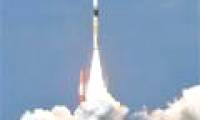
In August 1964, the first Nimbus satellite was launched into space, paving the way for a series of satellites to observe Earth later.

In May Africa will launch its first private satellite into space to track the changing weather and climate of the entire continent.

On November 19, the US launched a latest generation weather satellite capable of capturing weather and atmospheric phenomena at 30 seconds per image.

Japan Meteorological Agency (JMA) said on October 7, Japan successfully launched the Himawari-8 weather observing satellite from Tanegashima space center in Kagoshima Prefecture,

The European Aeronautics Agency (ESA) on May 9 officially announced the end of Envisat's mission, the world's largest environmental monitoring satellite, lost contact last month.

Soviet's first fully operational weather satellite Meteor-1, on March 26, fell back to the earth's atmosphere after more than four decades in orbit, the US Strategic Command said.

The latest images of the Earth are taken from a distance of 22,369 miles from Russia's Elektro-L 1 Weather Satellite, which has just been taken by surprise. The color taken from
 In August 1964, the first Nimbus satellite was launched into space, paving the way for a series of satellites to observe Earth later.
In August 1964, the first Nimbus satellite was launched into space, paving the way for a series of satellites to observe Earth later. In May Africa will launch its first private satellite into space to track the changing weather and climate of the entire continent.
In May Africa will launch its first private satellite into space to track the changing weather and climate of the entire continent. On November 19, the US launched a latest generation weather satellite capable of capturing weather and atmospheric phenomena at 30 seconds per image.
On November 19, the US launched a latest generation weather satellite capable of capturing weather and atmospheric phenomena at 30 seconds per image. Japan Meteorological Agency (JMA) said on October 7, Japan successfully launched the Himawari-8 weather observing satellite from Tanegashima space center in Kagoshima Prefecture,
Japan Meteorological Agency (JMA) said on October 7, Japan successfully launched the Himawari-8 weather observing satellite from Tanegashima space center in Kagoshima Prefecture, The European Aeronautics Agency (ESA) on May 9 officially announced the end of Envisat's mission, the world's largest environmental monitoring satellite, lost contact last month.
The European Aeronautics Agency (ESA) on May 9 officially announced the end of Envisat's mission, the world's largest environmental monitoring satellite, lost contact last month. Soviet's first fully operational weather satellite Meteor-1, on March 26, fell back to the earth's atmosphere after more than four decades in orbit, the US Strategic Command said.
Soviet's first fully operational weather satellite Meteor-1, on March 26, fell back to the earth's atmosphere after more than four decades in orbit, the US Strategic Command said. The latest images of the Earth are taken from a distance of 22,369 miles from Russia's Elektro-L 1 Weather Satellite, which has just been taken by surprise. The color taken from
The latest images of the Earth are taken from a distance of 22,369 miles from Russia's Elektro-L 1 Weather Satellite, which has just been taken by surprise. The color taken from

 NASA's 'Ninth Planet' Shows Signs of Being Friendly to Life
NASA's 'Ninth Planet' Shows Signs of Being Friendly to Life Why did American astronauts have to be quarantined when returning to Earth?
Why did American astronauts have to be quarantined when returning to Earth? China surprises the world by building a cable-stayed bridge 'above the clouds'
China surprises the world by building a cable-stayed bridge 'above the clouds' Why do women sleep less and wake up more than men?
Why do women sleep less and wake up more than men? Revealing the secret inside the stuffed animal claw machine, from there, summarizing experience to help you increase your winning rate many times over
Revealing the secret inside the stuffed animal claw machine, from there, summarizing experience to help you increase your winning rate many times over What would happen if you dug a hole through the Earth and jumped in?
What would happen if you dug a hole through the Earth and jumped in? Camera takes a photo that lasts 1,000 years
Camera takes a photo that lasts 1,000 years Was there nuclear war in ancient times?
Was there nuclear war in ancient times?